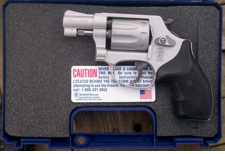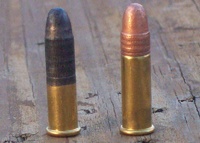
Innovations in firearms — real innovations — almost seem to be a thing of the past, don’t they?
I mean, imagine for a moment this is 1910. In the past five years, you would have witnessed the introduction of the Browning Auto-5, the first successful semiauto shotgun; the Remington Model 8, the first successful semiauto high-power rifle; and the Standard Model G, the first gas-operated autoloading rifle. What’s more, the Colt Model 1911 pistol and Winchester Model 12 pump shotgun would be just around the corner.
What a great time to be a shooter. Every day, it seemed, one of the big companies came out with something truly new and extraordinary.
It’s different today, of course. Today we work ourselves into a lather about this new cartridge, that new frame alloy, this new camo pattern or that new laser sight. Nothing wrong with that; these are improvements, and we’re properly appreciative of them. But true innovations — that kind that make you go all squishy inside — are few indeed.
My last squishy moment came in Fall 1997 at the old Bristol Sporting Goods store in northern Indiana. My mother had just died, and I was looking for a little trifle to distract my father from his troubles. All of a sudden, there it was in front of me: a brand-new Smith & Wesson Model 317 AirLite .22 snubbie.
Feeling Squishy
I had heard Smith & Wesson had introduced some new super-lightweight revolver but hadn’t actually seen one yet. I suppose I was expecting something like the old 15-ounce Colt Cobra, but when the guy behind the counter handed the AirLite to me, my first reaction was, “You gotta be kidding.”
This couldn’t possibly be a real gun — it was more like those super-loud Wasp capguns we had when I was a child; the ones that took plastic caps molded in a round, red little ringlet.
That little J-frame has now passed from my father back to me. In fact, it’s sitting on my desk as I write this, and my reaction is the same as when I first laid eyes on it: You gotta be kidding. It’s an early one with a serial number lower than 2,000, and it pretty much matches its description that appeared in the catalog section of the 1999 Gun Digest:
Smith & Wesson Model 317 AirLite, 317 LadySmith Revolvers.
Caliber: .22 LR, eight-shot.
Barrel: 1-7/8 inches.
Weight: 9.9 ounces.
Length: 6-3/16 inches overall.
Stock: Dymondwood Boot or Uncle Mike’s Boot.
Sights: serrated ramp front, fixed notch rear.
Features: aluminum alloy, carbon and stainless steels, and titanium construction. Short spur hammer, smooth combat trigger. Clear Cote finish. Introduced 1997. Made in U.S. by Smith & Wesson.
Price: With Uncle Mike’s Boot grip: $451.
Price: With Dymondwood Boot grip: $484.
Price: Model 317 LadySmith (Dymondwood only, comes with display case): $505.
I still have the receipt for my Model 317, and it says I paid $449 for it — nearly full retail. I never buy guns for anything near the manufacturer's suggested retail price, so I must have been very impressed with the AirLite. I still am, come to think of it.
Remarkable Combination

Gun Digest must have been asleep at the switch in 1996 and 1997. It didn’t get around to mentioning the AirLite in print until the 1999 edition, and that was limited to a single sentence in the “Handguns Today” section by Hal Swiggett:
“[At the SHOT Show], the one that caught my eye was the Model 317 AirLite, an eight-shot .22 with 2-inch barrel, weighing only 9.9 ounces.”
In my opinion, the AirLite rated much more of a hullabaloo than that; maybe something on the order of a 72-point banner headline screaming: “S&W INTRODUCES LIGHTEST DA REVOLVER EVER!”
That’s pretty much what the AirLite was. Its most similar predecessor was the old aluminum-framed, nine-shot Hi-Standard Sentinel .22 snubby, which came in at around 16 ounces with a 2-inch barrel.
The Sentinel was a great gun (notwithstanding its tendency to shoot high at almost any distance), but compared to the AirLite, it was a bloated heavyweight.
The AirLite achieved its remarkable weight by a combination of carbon steel (barrel, hammer and trigger) and aluminum or titanium alloys (everything else), plus strategically placed milled-out areas (grip strap and trigger guard). In all, it adds up — or subtracts down — to a revolver that feels like it’s made of molded Styrofoam.
Early as it is, my M317 didn’t come from the first production run. According to Supica & Nahas in Standard Catalog of Smith & Wesson (Krause Publications, naturally), the earliest Model 317s carried a serial number prefix of “ULT,” which was followed quickly by the “LGT” prefix. The Model 317-1 designation was used for the still-later adjustable-sight versions and a very rare 2-inch snubby with a stainless-steel barrel manufactured in 2000. Only 120 of those were made, so it’s the rarest of the AirLites. (If you find one, buy it. Better yet, tell me where I can buy it.)
Mixed Reviews
Current opinion of the M317 AirLite is mixed. It’s one of those love-it-or-hate-it things. I love it, of course. Others find fault with its sleeved barrel; plastic-looking Clear Cote finish; short, sharp hammer spur, which makes single-action operation uncomfortable at best; and its stippled serial and model number on the crane recess and butt.
Still others say the Model 317 AirLite is a gun without a purpose.
“What good is an eight-shot, fixed-sight .22 snubby?” they ask.
That’s a pretty good question, one for which I have no ready answer. The AirLite is a descendant of the original Model 34 Kit Gun, which in my opinion is probably the finest, most gracefully economical .22 revolver ever built. The original Kit Gun, as you will recall, had an adjustable rear sight, even in its 2-inch version — quite a desirable feature if you shoot a variety of .22 ammo and really like to dial 'em in there.
Smith & Wesson must have recognized that right off the bat, because in 1998, it introduced the Model 317 AirLite Kit Gun, an adjustable-sight version of the original AirLite with a 3-inch barrel. So where does that leave the plain old M317 AirLite?
The only possible answer is that it was intended as a supremely portable self-defense bellygun. This supposition is supported by the AirLite’s combat grips and bobbed hammer spur. It even has a crosspin for a lanyard concealed in the outline of its grip frame, I suppose if you literally wanted to tie one on.

Regrettably, any discussion of the AirLite as a self-defense gun begins and ends with its .22 LR chambering. I’m a big believer in the .22 LR, but if I knew I’d need a defense gun in the next two minutes, I’d reach for a .38 Special or, at a minimum, a .32 ACP (and that’s assuming a .45 Colt is out of reach). The AirLite must have been intended for a consumer who prefers revolvers, believes in the stopping power of eight .22 LRs, will be shooting only at combat distances or puts light weight above any other characteristic. That’s a pretty skinny demographic.
If I were to carry the AirLite as a defense gun, I’d probably stoke it full of the Aguila 60-grain (that’s right, 60-grain) .22 SSS Sniper Sub-Sonic .22 LR ammo rather than something like a CCI stinger. I don’t really trust any of the hyper-velocity .22s to expand reliably out of a 2-inch barrel, but I’m pretty sure that Aguila’s 60-grainer would burrow in pretty deep.
Or maybe S&W introduced the AirLite just to show the world only it could build a 9.9-ounce revolver. If that was the case, well all right then. It's a good enough reason for me, but the fact remains that I don’t see many first-generation Model 317 Airlites, new or used, floating around out there. To me, that’s one earmark of a sleeper-in-waiting.
How does the AirLite shoot? Who cares? It’s a belly gun, so you’re pretty sure to hit any belly you’re aiming at, especially if that belly, like mine, resembles something that blew up in Lakehurst, N.J., in 1937. Oh, the humanity.
The Current Scene
The Model 317 AirLite still exists in the S&W lineup in the form of the original 2-inch, fixed-sight bellygun, and as an updated kit gun with a 3-inch barrel, adjustable rear sight and HI-VIZ front sight. Both versions have the now-familiar-but-nevertheless-ugly S&W safety lock just above the cylinder release. Suggested retail is $672 and $735, respectively (ouch). Street pricing runs from five to six big bills. (Ouch again.)
I’m the last person to suggest that you should run out and buy a brand-new AirLite for $500 or $600. But if you’re offered a good deal on one, you might consider it. If nothing else, it’s the finest cap gun ever made.

Next Step: Get your FREE Printable Target Pack
Enhance your shooting precision with our 62 MOA Targets, perfect for rifles and handguns. Crafted in collaboration with Storm Tactical for accuracy and versatility.
Subscribe to the Gun Digest email newsletter and get your downloadable target pack sent straight to your inbox. Stay updated with the latest firearms info in the industry.








I have a Model 317-1m S&W Kit gun with adjustable sights and a 3 inch barrel which I bought new in 2002. My sons and I have shot this little gun quite a bit and it is very accurate with CCI Mini Mag HP’s,easily shooting 1-1/2 inch groups at 15 yards. I do not intend to ever part with this revolver and will pass it on to one of my son’s when I can no longer use it.